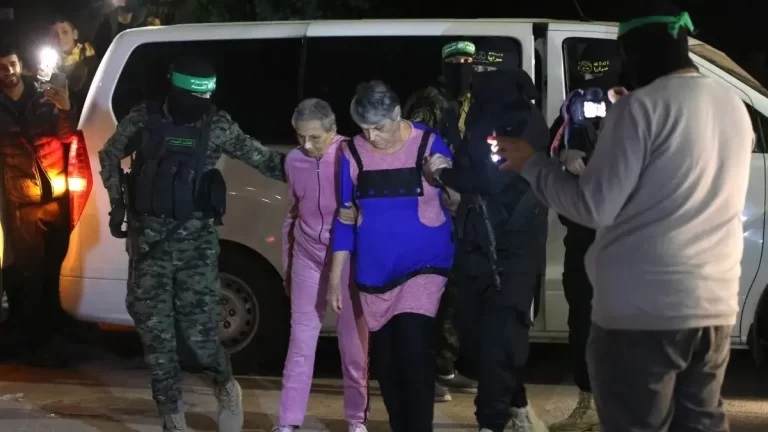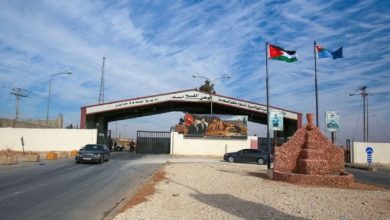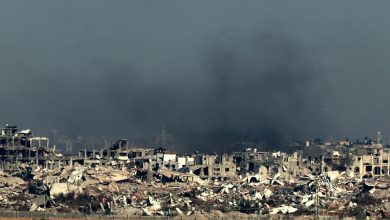Gaza Peace Proposal: Framework for Sustainable Calm and Prisoner Exchange

Watan-Within hours, Hamas is expected to deliver its response to the offer conveyed to it by the Egyptian side last Friday (April 26, 2024), as the Lebanese newspaper “Al-Akhbar” published the full text of the proposal to be implemented in case of agreement on 3 stages.
The proposal is described as “basic principles for an agreement between the Israeli side and the Palestinian side in Gaza regarding the exchange of detainees and prisoners between the two sides and the return to sustainable calm.”
The framework agreement aims to release all Israeli detainees in the Gaza Strip, whether civilians or soldiers, whether they are alive or not, from all periods and times, and to return to sustainable calm, including taking necessary measures to reach a ceasefire. The framework agreement consists of 3 stages, as follows:
Stage One (40 days, with the possibility of extension)
Temporary cessation of military operations between the parties, and the withdrawal of Israeli forces eastward and away from densely populated areas to an area near the border in all areas of the Gaza Strip (except Gaza City as specified below). Ceasefire (military and reconnaissance) in Gaza for 8 hours a day, and for 10 hours on days of detainees and prisoners release. Return of civilian displaced persons to their residential areas:
On the seventh day (after the release of all women),Israeli forces withdraw from Rashid Street eastward, parallel to Salah al-Din Street, in a manner that facilitates the entry of humanitarian aid, allows the beginning of the return of unarmed civilian displaced persons to their residential areas, and grants freedom of movement for civilian populations in all areas of the Strip.
On the 22nd day (after the release of two-thirds of the detainees), Israeli forces withdraw from the center of the Strip (especially the Martyrs’ axis in Netzarim and the Kuwait roundabout axis) east of Salah al-Din Road to an area near the border, allowing the return of civilian displaced persons to their residential areas in the north of the Strip.
Facilitating the entry of suitable quantities of humanitarian aid, relief materials, and fuel (500 trucks, including 50 fuel trucks, 250 to the north) including the fuel necessary to operate the power station, trade, equipment necessary for rubble removal, and rehabilitation and operation of hospitals, health centers, and bakeries in all areas of the Gaza Strip, and continuing this in all stages of the agreement.
Exchange of detainees and prisoners between the parties,Hamas releases at least 33 detainees, including all living Israeli detainees, such as women (civilians and recruits), children (under 19), seniors (over 50), patients, and wounded. Hamas releases all living Israeli detainees, such as civilian women and children (under 19), in return, Israel releases 20 children and women for each Israeli detainee released, based on lists submitted by Hamas according to the oldest in detention.
Hamas releases all living Israeli detainees, such as seniors (over 50), patients, and wounded, in return, Israel releases 20 elderly prisoners (over 50 years old) and patients and wounded (with no remaining sentence exceeding 10 years) for each Israeli detainee released, based on lists submitted by Hamas according to the oldest in detention.
Hamas releases all Israeli female recruits still alive (who were in actual military service on October 7, 2023), in return, Israel releases 40 prisoners from its jails for each female Israeli recruit released (20 sentenced to life imprisonment, and 20 sentenced to no more than 10 years, based on lists submitted by Hamas, with the Israeli right of refusal (not exceeding 200 names).
Each of the prisoners sentenced to life imprisonment and whose release is agreed upon may be released abroad or in Gaza. Schedule for the exchange of detainees and prisoners between the parties in the first stage: Hamas releases 3 Israeli detainees on the first day of the agreement, and thereafter, Hamas releases 3 other detainees every three days starting with all women (civilians and recruits) until day 33.
In return, Israel releases the agreed number of Palestinian prisoners in Israeli prisons, according to agreed lists. By the seventh day (at the latest), Hamas will provide a list of all remaining detainees (in addition to the mentioned 33) from the aforementioned categories, to be released on day 34, where the ceasefire agreement will be extended for several days according to the remaining number of detainees (one additional day for each additional detainee released).
In return, Israel will release the agreed number of Palestinian prisoners in Israeli prisons, according to agreed lists. The exchange operations are linked to the extent of commitment to the agreement terms, including cessation of hostile operations, redeployment of forces, return of displaced persons, and entry of humanitarian aid. Formerly released Palestinian prisoners shall not be re-arrested based on the same charges for which they were previously arrested.
The above-described keys to the first stage do not form the basis for negotiations on the keys to the second stage. By day 16 of the first stage (after releasing half of the detainees), indirect talks will begin between the parties regarding the agreement on necessary arrangements for the return of sustainable calm. The United Nations and its relevant agencies and other international organizations will continue their humanitarian efforts in all areas of the Gaza Strip, continuing throughout all stages of the agreement.
Commencing the rehabilitation of infrastructure (electricity, water, sanitation, communications, and roads) in all areas of the Gaza Strip, and introducing equipment coordinators necessary for civil defense, rubble and debris removal, and continuing throughout all stages of the agreement. Facilitating the entry of supplies and requirements necessary for establishing shelter camps to accommodate displaced persons who have lost their homes during the war. Starting from day 14, an agreed-upon number of wounded military personnel will be allowed to travel through the Rafah crossing for medical treatment.
Stage Two (42 days)
Finalizing the necessary arrangements for the return of sustainable calm and announcing its commencement before commencing the exchange of detainees and prisoners between the parties – all remaining living Israeli men (civilians and soldiers) – in exchange for an agreed-upon number of prisoners in Israeli prisons and detainees in Israeli detention camps, and the withdrawal of Israeli forces from outside the Gaza Strip. Commencing the necessary arrangements for a comprehensive reconstruction process of destroyed homes, civilian structures, and civilian infrastructure due to the war.
Stage Three (42 days)
Exchanging all bodies and remains of the deceased on both sides after identification. Commencing the implementation of a 5-year Gaza reconstruction plan, including homes, civilian structures, and infrastructure. The Palestinian side refrains from rebuilding military infrastructure and facilities and does not import any equipment or raw materials or other components for military purposes. Guarantors of the agreement: Qatar, Egypt, and the United States.






